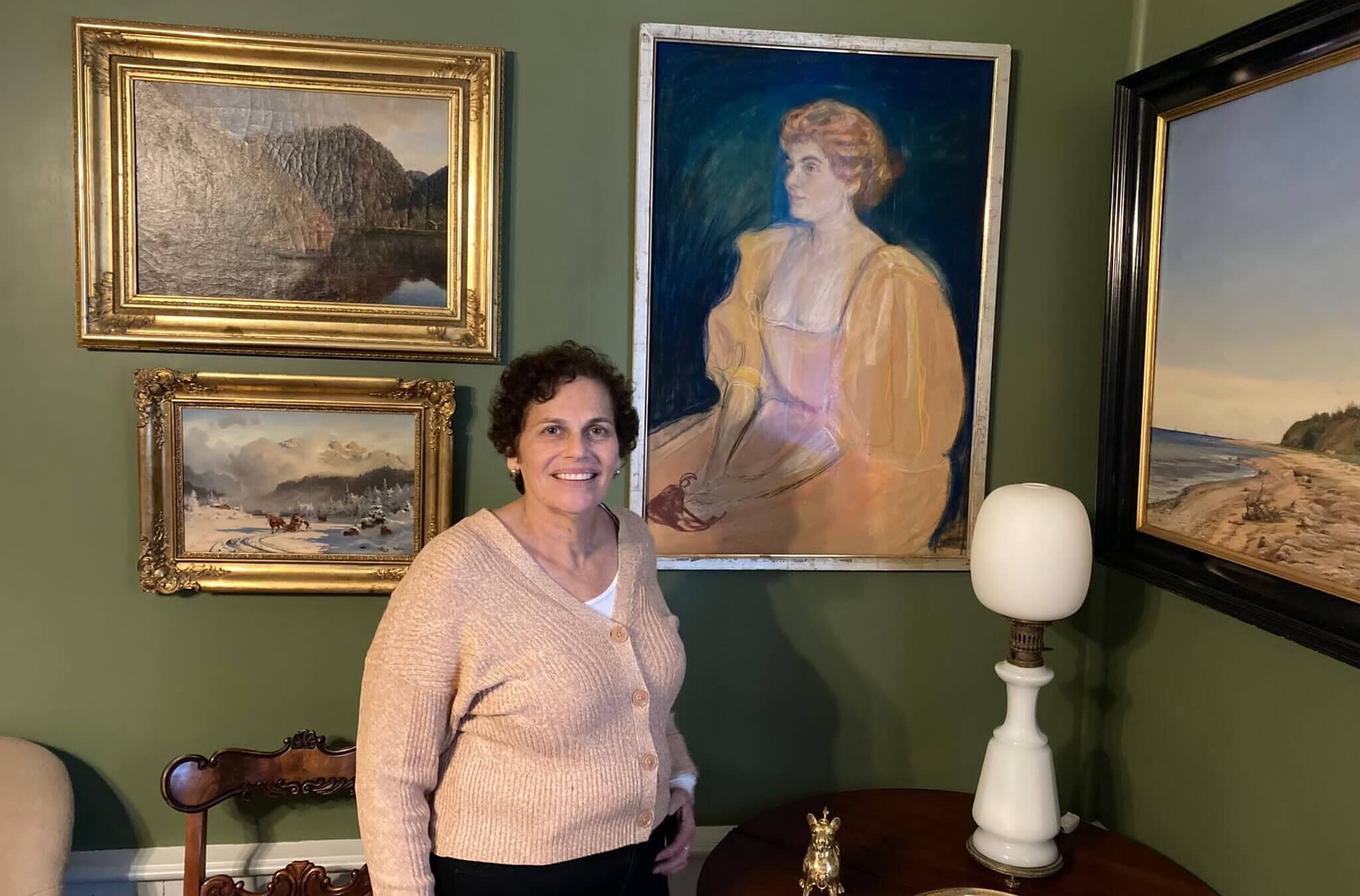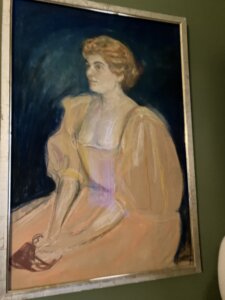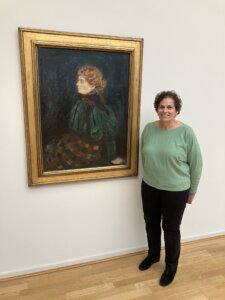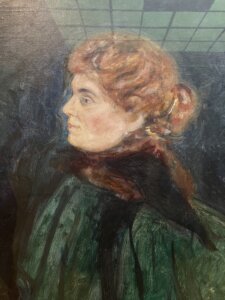One of the world’s greatest artists painted my great-grandmother’s portrait — but who was Selma Fontheim?
The search to find the history behind two portraits painted by Edvard Munch

The author with an Edvard Munch portrait of Selma Fontheim. Courtesy of Alina Tugend
In the Hamburger Kunsthalle art museum, one of the largest in Germany, there’s an oil painting by the great Norwegian artist Edvard Munch. A woman in her early 30s sits in profile, reddish gold hair tied back, a scarf around her neck atop a jewel-toned green dress.
The subject of this portrait, completed in 1894, is Selma Fontheim, a typical upper-class German Jewish woman of the day. At the time, she was married to the factory owner Siegfried Fontheim — nearly a decade her senior — and the mother of three young children. Several years later, Selma left her husband and children to live with Maximilian Harden, one of the leading journalists and intellectuals of late 19th and early 20th century Germany.
Selma Fontheim was my great-grandmother. One of the three children she left behind to live with Harden was my grandmother, Irene Tugendreich née Fontheim, a beloved figure in my life. My father, Tom Tugend, who passed away last December at the age of 97, was Selma’s grandson.
When I think back to how I learned about Selma, it is a story of random phrases that my dad said at different times over the years; imagine a tone that is neither sad nor shocked, but slightly amused at this curious piece of family history: “Left her husband and children.” “Married a journalist who was hated by the Kaiser.” “A scandale!” (always with the somewhat French pronunciation.)
A second painting
I don’t recall when I was learned that Munch had painted this Selma’s portrait; all I remember is that I was interested and, to some extent, impressed, but — once it was clear we had no claim to the painting — I didn’t give it much thought.

About a decade ago, we learned there was a second Munch painting of Selma, a reworking of the first portrait, this one housed in Norway. I later discovered that my father heard of both paintings through another one of Selma’s grandchildren, Eva Werner — the daughter of the child Selma had with Harden. Eva lives outside Paris, Tom lived in Los Angeles, they were almost two decades apart and their only connection was Selma, but they stayed in sporadic touch throughout the years.
Then Dr. Benjamin (Benni) Kuntz came into our lives. A researcher in public health in Berlin, he learned about my grandfather Gustav Tugendreich’s pioneering initiatives in public health in the early part of the 20th century. When he began his research in 2017, he was surprised to discover that Gustav’s son was not only still alive — but very much online as a journalist for a number of Jewish publications in the U.S. and abroad.
Through a serendipitous set of events, Benni flew twice from Berlin to Los Angeles to interview my father and wrote a book about my grandfather that was published in 2019 as part of a series called Jüdische Miniaturen (Jewish Miniatures). Even after the book was complete and Benni had moved on to other work, he remained fascinated by certain parts of our family history.
At one point, he proposed that he and I — both writers — travel to Hamburg and Rosendal, Norway, to see the two pictures in person.
So, in 2023 — 160 years after Selma and Munch were born, both in 1863, and 84 years after the Tugendreich family escaped Nazi Germany — we went looking for Selma.
A painting’s journey
We first visited the oil painting in Hamburg. Shortly after it was finished, Selma had loaned it to Munch for an exhibition he was having in Berlin, and then lost track of it for years while her life was in turmoil. In 1913 — nearly 20 years after it was painted — she wrote to the artist asking where it might be and if she could have it back. It turned out that it had initially been confiscated from the gallery show for the artist’s unpaid tailor bills and then ended up in a Berlin hotel. Eventually Munch located it and sent it back to Selma.

In a letter to Munch seeking the painting, Selma wrote that “your master hand had understood how to bring out everything that was dormant in my innermost being.” Perhaps, but looking at the serene face, no one would know that Munch captured Selma on the precipice of her new life.
That second painting was apparently not commissioned by the Fontheim family. It was most likely, according to experts, a reworking of the original oil portrait that Munch did for his own pleasure; he often liked to create variations of his artworks as demonstrated by four versions of his most famous piece “The Scream.”
This simpler portrait, in soft pink pastels, was part of a Christmas lottery in Oslo in 1895. A Norwegian baron won and it has hung in the baron’s home for more than a century. The property, in the stunning area of Rosendal — about 240 miles west of Oslo — now houses the historic home and sprawling gardens where classical music concerts are held throughout the summer.
I was the first blood relative to ever see Selma in Norway.
In learning about Selma and her story, we uncovered layer upon layer of complexity. The portraits display a placid, affluent woman of a certain age. Not the woman who became pregnant in 1899 with her lover’s child and left her husband and other three children. Who traveled to Harden when he was imprisoned for political reasons so she could give birth to their daughter near him. Who co-founded the German-French Society in Berlin to bring the two nations closer together, who was a spendthrift, who adored a man who had long-time mistresses and who often treated her with disdain.
Harden himself was brilliant and difficult. His politics swung from deeply nationalistic before World War I to radical socialism after. He edited a weekly magazine (“Die Zukunft/“The Future”) where he regularly reported on scandals surrounding the German Kaiser and was despised by his critics, of which there were many. He barely survived an assassination attempt with a hatchet; at the time of his death in 1927, Joseph Goebbels, chief propagandist for the Nazi party, called Harden “a scribbling Jewish beast” and one of the “basest and most infamous individuals who ever brought Germany to the brink of doom.”
When Selma committed suicide in 1932, at the age of 68 — five years after Harden died — her obituaries in the German newspapers depicted her as a tirelessly loving wife, who protected and served her husband. Felix Salten, the author of the world-famous story of Bambi, who had been friends with Harden, wrote in an obituary that “princes, ministers and ambassadors knocked on the door of this tiny house. All passed before the blond, stocky woman with the clear and yet impenetrable face, with the clever inquiring eyes, with the fine thin lips that never let too many words slip out.”
In 1938, fleeing to Palestine, Selma’s only child by Harden, Maxa, took the portrait. For a while, it hung in a museum in Tel Aviv. She then returned with her husband and daughter, Eva, to live back in her cherished Berlin. In 1953, in devastated post-war Germany and after her husband’s unexpected death, troubled finances forced Maxa to sell the family heirloom to the Hamburger Kunsthalle museum, where it has resided ever since.
A sort of immortality
I look at the portraits — and people say there is a resemblance between Selma and me that I can’t see — and I wonder at how this woman’s story that once felt so distant has become so near. I feel great sadness thinking of my grandmother, who was abandoned by her mother when she was 8 or 9, and by all accounts, rarely saw her again.

I never thought about that when hearing about “the scandale “ and I can’t recall talking to her about her childhood — but then I was only 16 when she died. I wonder how Selma’s desertion and notoriety impacted my grandmother and my father — and me, my sisters and our children.
I also wonder what Selma was like, a woman who, in the 19th century could defy convention so singularly. Her life seems largely tragic and so does her afterlife; events conspired to ensure her one great desire — to be a Harden and not a Fontheim — was thwarted. She asked to be interred alongside Maximilian; he is buried in a Berlin cemetery under a sarcophagus with the quote, in German, “No conqueror’s power endures like thought.”
Selma’s life, on the other hand, was reduced to a simple small plaque bolted to the front with her name and dates of her birth and death. At some point, the plaque disappeared, probably stolen for the metal. Except for the four holes where the bolts once were, there is no longer any sign that she lies there with the love of her life.
And the immortality she achieved by being painted by one of the most influential figures in modern art? There, she is identified as Selma Fontheim. Not by her maiden name, Isaac, nor by the name of her great love, but the name of the husband who paid for the painting.






















